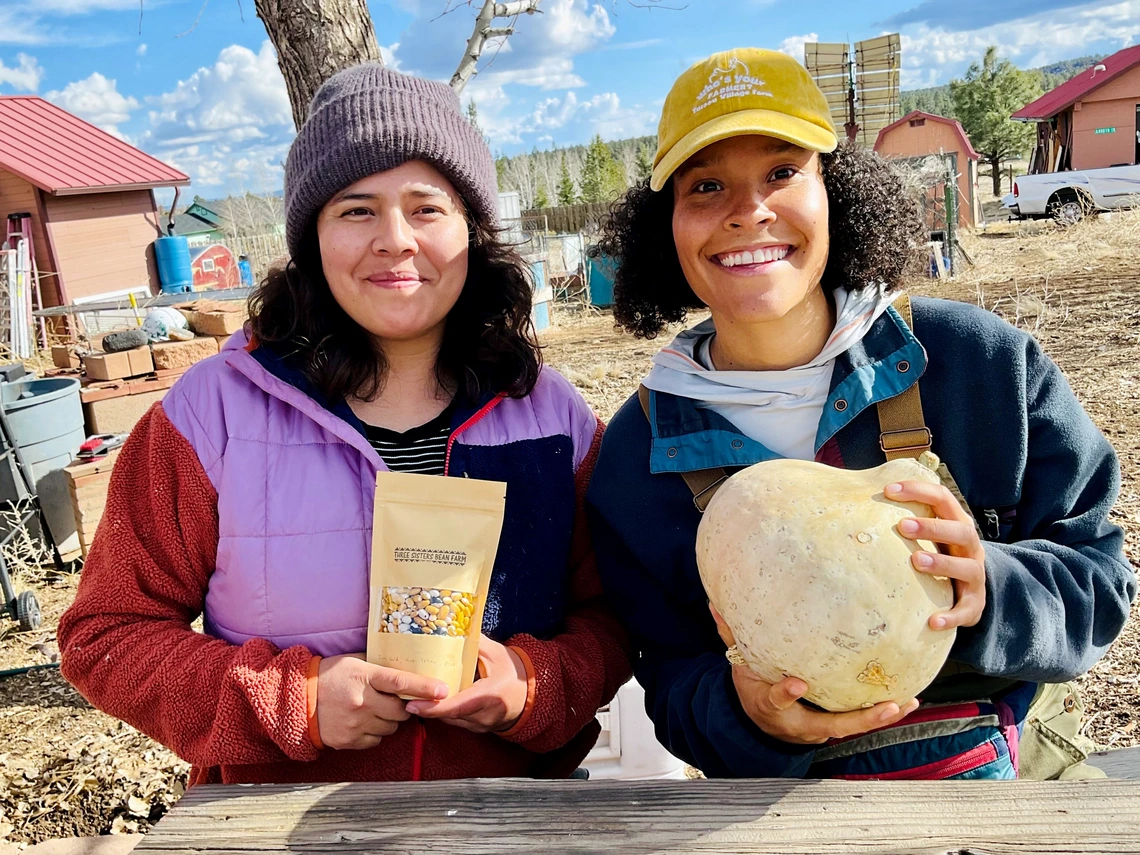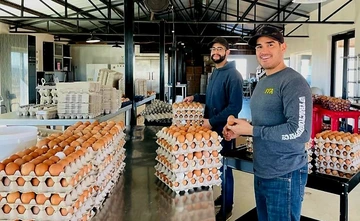Extension connects farms, ranches with Arizona workforce
The Agriculture Workforce Development Program, focused on historically underserved populations, reimburses food producers who hire people interested in food production careers. The program helps growers stay profitable and apprentices get experience.

Sara Sprague (left) and Shonri Begay worked as apprentices at Superyard Farms, which helps communities create farms in open spaces. After her apprenticeship, Begay launched Three Sisters Bean Farm in Coconino County.
Cooperative Extension
For thousands of years in Arizona – long before Europeans set foot here - agriculture was at the heart of culture, livelihood and commerce. But in recent decades, young people have drifted away from agriculture as a career.
One Cooperative Extension program is stemming that flow.
The Agriculture Workforce Development Program reimburses food producers who offer apprentices work on food-producing farms or ranches.
“It has been very successful,” said Maritza Broce, the AWDP coordinator. “Right now, we have a huge waiting list."
Apprentices must be over 18 and complete 130 hours of work in the yearlong program, which must provide meaningful work on farms that produce food. Hosts are reimbursed up to $10,000 for each apprentice and can hire up to two per year. Extension has placed more than 90 farm workers on 46 host farms in 13 of Arizona’s 15 counties.
“We place people who are interested in going into careers in agriculture, not just the next farmer or rancher. We want that, but we also want the person who’s going to run the farmer’s market. We want the restauranteur who’s going to do farm-to-table,” Broce said.

Gabriel Cruz (right) hired two apprentices under Extension's Agriculture Workforce Development Program to work at his Cruz Farm in Santa Cruz County, where he produces eggs, beans and pecans.
Photo courtesy Cruz Farms
Hannah Gyer completed an apprenticeship at Rosebird Farms in Mohave County, where owner Andrea McAdow grows organic produce.
“Through this apprenticeship I have been inspired to build my own small-scale organic farm and have learned the necessary skills to build a successful business and have made impactful connections with other small businesses around me. The memories that I have made while working at Rosebird Farms will last with me for a lifetime,” Gyer said.
Hosts are drawn from historically underserved populations – former military and new or socially disadvantaged farmers or ranchers, such as women or racial minorities.
“Part of the mandate from the state Legislature was to prioritize rural and tribal producers, so we do have tribal members as hosts and apprentices. We’ve had veteran apprentices and hosts, and we have overwhelming women participation, so we’ve really embraced that,” she said.
More than 80 percent of the host producers are BIPOC or women. Just over half are women, 43 percent are BIPOC, and 21 percent are Native American. Among apprentices, 78 percent are BIPOC or women, and 21 percent Native American.
Teresa Showa runs the 7-acre Ganado Family Farm on the Navajo Nation near Window Rock, Arizona. She hired an apprentice to help grow vegetables and other crops.
“I have been growing our Navajo White traditional corn, various squashes, pumpkins, grasses, legumes, and cover crops for over 25 years. I have been inspired to keep my Navajo culture alive through the food crops I produce, mainly the corn products derived from our traditional corn,” she said.
Two vineyards have hosted apprentices, along with a range of other food producers, Broce said.
“Every apprenticeship looks different, because every host farm is different. We have lavender farms. We have vegetables. We have herbal. In Payson, I have a mushroom farm, and then I have a few ranchers,” she said.
Working with smaller farms often gives apprentices a broad range of experience.
“These apprentices are doing a little bit of everything, because they’re on a smaller operation, as opposed to a large, ag industry farm, where they would most likely be centered in one area,” Broce said.
Gabriel Cruz is an egg producer in Santa Cruz County. He hosted two interns – one to work on egg production, and one to do marketing. They’ve learned a lot. His marketing apprentice has helped with egg labels and invoicing and was one of the 60 percent of apprentices hired after internships ended.
Cruz’s other apprentice, Adrian Carillo, is also learning a spectrum of skills, Cruz said.
“He’s indispensable to our farm operations. Adrian’s apprenticeship has also included biosecurity training, as we are working to prevent the spread of avian flu. We’re proud of creating greater awareness of the importance of biosecurity in safeguarding food production and human health,” he said.
The state allocated $1 million for the first two years of ADWP, then added another two years and $1 million last year. Apprentices earn at least minimum wage, but that varies across that state. ADWP is urging hosts to pay more, Broce said.
“We’re now recommending a minimum of $16.55. Our current average wage is $19.55,” she said.
Ethan Orr, Arizona Extension associate director for Agriculture, Natural Resources and Economic Development, spotlights the economic impact of AWDP.
“This is a very important program that connects the strength of our state economy to the goals of farmers, ranchers and the next generation workforce. It is imperative that we look forward to the future by providing meaningful and well-rounded experience to apprentices who are interested in becoming the state's next economic driving force in farming and ranching.”
Learn More
To learn more or get involved, see our Agriculture Workforce Development Program page.

